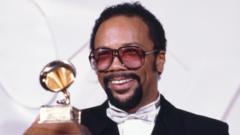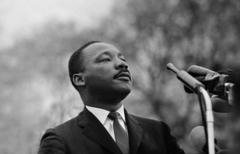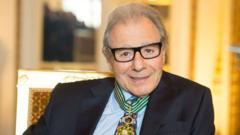Quincy Jones lived for 50 years after attending his own memorial service, which was orchestrated by famous friends anticipating his demise following a brain aneurysm in 1974. Surviving against the odds, Jones, 41 at the time, had already etched a deep imprint on American music history as an outstanding performer, arranger, songwriter, producer, and record executive. His journey began in the vibrant jazz clubs of the 1950s, where he mastered various genres, including soul and pop, collaborating with icons like Dinah Washington and Frank Sinatra.
The memorial concert that continued even after his survival featured stellar performances from Richard Pryor, Marvin Gaye, and Sarah Vaughan, among others. “That was hard to do with all that love and talent in the room,” Jones recounted to Newsweek in 2008. His story didn't end there; notable partnerships followed as he worked alongside Michael Jackson, directed the globally significant “We Are the World,” and produced hits for contemporaries like Chaka Khan and Donna Summer.
Born during the Great Depression, Jones grew up in the challenging environment of Chicago’s South Side, against a backdrop of violence, poverty, and familial struggles. With ambitions that were initially set on the criminal lifestyle, a chance encounter with a piano in a community center at age seven redirected his path forever. “Every cell in my body said, ‘this is what you’ll do for the rest of your life,’” he shared in a 2016 interview.
By age 14, Jones was already making waves in the music scene, collaborating with legends like Ray Charles and Billie Holiday. His talent quickly gained recognition, and after navigating substantial challenges in his early career—including a major debt from an overseas tour—he broke barriers as the first African-American vice president of a major record label in 1961. His creative prowess was showcased in the hit single “It's My Party” by Lesley Gore, and his infectious track “Soul Bossa Nova” became a cultural staple.
The artist's credibility soared as he arranged albums for Frank Sinatra and collaborated with other music giants of the era, solidifying his place among the best. Beyond music, Jones played a significant role in film and television, composing soundtracks for iconic productions like “Roots” and “The Italian Job,” while receiving multiple Oscar nominations.
However, it was his partnership with Michael Jackson during the 1980s that truly defined an era. Producing the phenomenally successful “Thriller,” Jones seamlessly blended R&B and pop, crafting a legacy that continues to influence the music industry. His keen sense for collaboration led to transformative tracks such as “Beat It,” featuring a legendary guitar solo by Eddie Van Halen.
Throughout the following decades, Jones embraced new genres, including hip-hop, aligning his experiences with many artists who similarly rose from the streets. His commitment to creating a positive impact extended beyond music; he championed social activism, meeting Martin Luther King Jr. and establishing various foundations to uplift communities.
Despite facing health issues and personal struggles, including three marriages and resilience against addiction, Jones’ dedication to his craft never wavered. His passing at 91 has left a 'gaping void' in the music industry, and as the world mourns, we reflect on the profound legacy he leaves behind—a reminder of the power of music to inspire, heal, and connect. In a world ready to pay tribute, another memorial concert for Quincy Jones is surely on the horizon, as his contributions to the art will always remain celebrated.





















